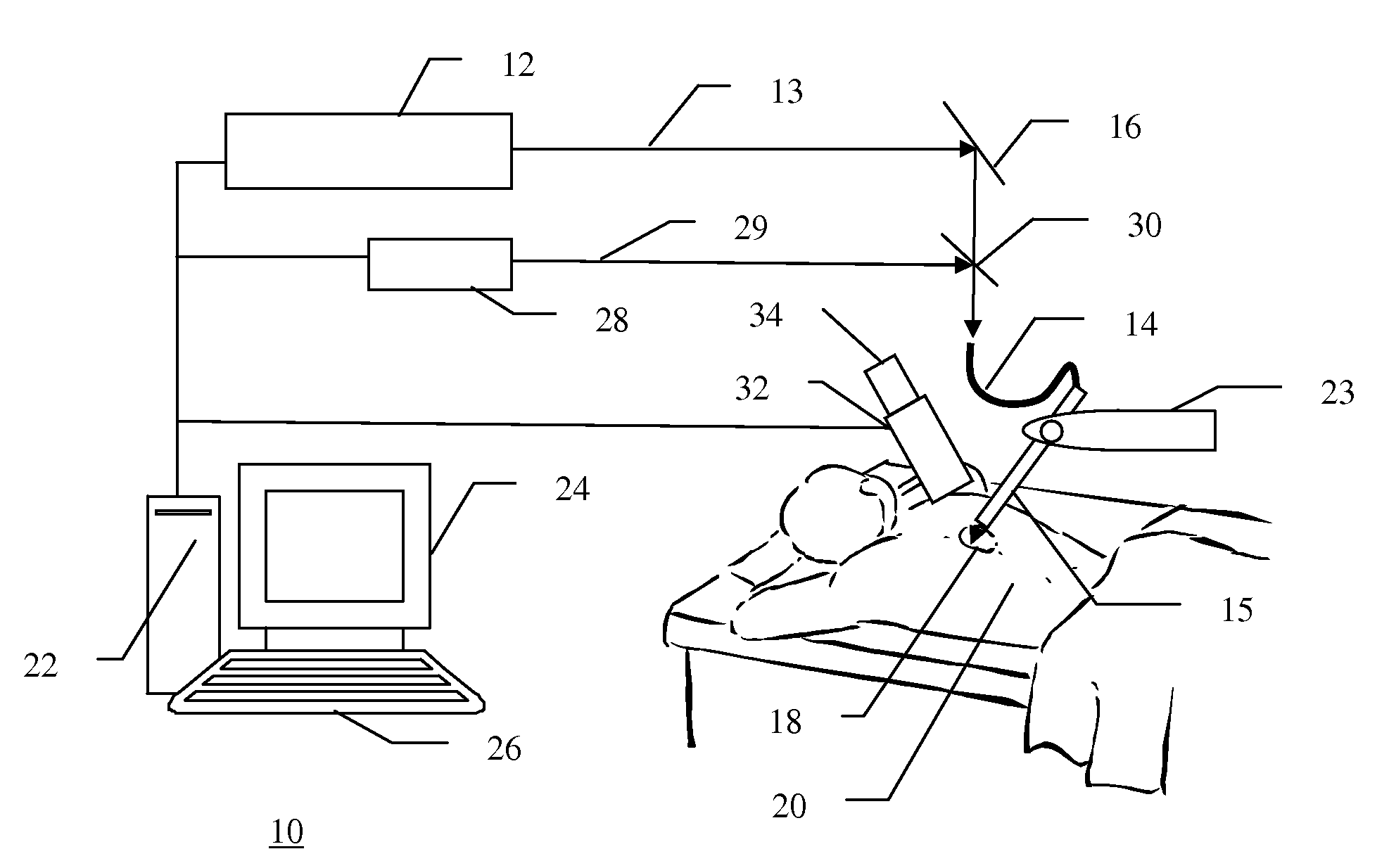Tattoo Removal and Other Dermatological Treatments using Multi-Photon Processing
a multi-photon processing and tattoo technology, applied in the field of tattoo or blemish removal, can solve the problems of no or negligible thermal heating or shock of any surrounding material, and achieve the effect of little or no damage to the surrounding tissu
- Summary
- Abstract
- Description
- Claims
- Application Information
AI Technical Summary
Benefits of technology
Problems solved by technology
Method used
Image
Examples
example 1
[0038]The use of multi-photon processing to remove tattoos has been demonstrated using a pulsed Ti:Sapphire laser with a pulse duration of approximately 100 fsec. A frozen pig foot obtained from a butcher was thawed and a three color tattoo was laid down on the skin (K & B Tattooing and Piercing, Hightstown, N.J.). The colors were red, green, and black, and the tattoo measured approximately 5 cm by 3 cm. Pig skin was chosen for the experiments because it is anatomically and physiologically very similar to human skin as detailed in, for instance, the article published by Sullivan et al entitled “The pig as a model for human wound healing.” In Wound Repair Regen. (2):66-76, 2001, the contents of which are hereby incorporated by reference. This 100 fsec , 1 mJ per pulse laser operating at 10 Hz repetition rate was focused at a point about 100 to 200 μm below the surface of the skin. A patch of green dye was then treated. Similar results were obtained on red dye and black dye, demonstra...
example 2
[0039]The use of multi-photon processing to remove tattoos has also been demonstrated using pulsed Ti:Sapphire laser with a pulse duration of about 10 psec. A frozen pig foot obtained from a butcher was thawed and a six color tattoo was laid down on the skin (K & B Tattooing and Piercing, Hightstown, N.J.). The colors were red, green, blue, orange, yellow and black, and the tattoo measured approximately 5 cm by 3 cm. The laser used had an energy of ˜10 mJ per pulse and was run at a 10 Hz repetition rate. The laser was focused at a point about 100 to 200 μm below the surface of the skin. A section containing all colors of the tattoo was then treated. The eradication of all dyes using this 10 psec laser was clearly evident, although not as good as with 100 fsec laser.
example 3
[0040]The multi-photon processing to remove tattoos was contrasted with photo-thermal ablation removal of tattoos by using a nsec-type laser with a pulse duration of about 10 nsec to remove a different section of the same tattoo described in Example 2. The 5 nsec, 200 mJ / pulse Nd:YAG laser was focused at a point about 100 to 200 μm below the surface of the skin. The eradication of the some of the dyes was clearly evident, but some dyes were not removed because the wavelength of the laser (1.064 μm) was not a good match to the dye. Importantly, when enough laser energy was used to remove the tattoo, the heating of the skin was intense and the skin damage was severe, and sections of the skin were severely burnt. The contrast with the treatments using ultrashort laser pulses (Examples 1 and 2) was dramatic.
[0041]The multi-photon processing system and method of the present invention, described and demonstrated above, permits the fast and complete removal of tattoo pigments in the skin a...
PUM
 Login to View More
Login to View More Abstract
Description
Claims
Application Information
 Login to View More
Login to View More - R&D
- Intellectual Property
- Life Sciences
- Materials
- Tech Scout
- Unparalleled Data Quality
- Higher Quality Content
- 60% Fewer Hallucinations
Browse by: Latest US Patents, China's latest patents, Technical Efficacy Thesaurus, Application Domain, Technology Topic, Popular Technical Reports.
© 2025 PatSnap. All rights reserved.Legal|Privacy policy|Modern Slavery Act Transparency Statement|Sitemap|About US| Contact US: help@patsnap.com



